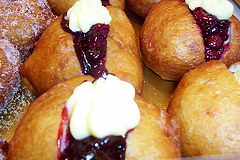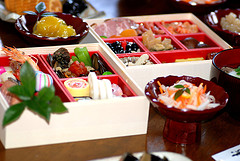New Year’s – Eating Your Traditions
If you thought that what you eat on New Year’s Day was simply a matter of “that’s what I’ve always done” – you might be right. But, your tradition might be based on centuries of belief. Many cultures prepare New Year’s foods that are believed to influence good fortune; or, avoid dishes that might cause misfortune.
In many Spanish-speaking countries, eating one grape at each stroke leading up to midnight (12 grapes for the next calendar year), is for good luck. If the grape for the corresponding month is sweet, so goes that month. If, however, the grape is sour, don’t expect a good month. Of course, no matter sweet or sour, by the stroke of midnight, unless you chew very fast, you’ve got a mouth full of grapes.

Ollie Bollen (photo credit: Faye Martel) |
Ollie Bollen – literally “oil balls” – are a traditional New Year’s confection in Holland. These puffed doughnuts are frequently filled with currants, raisins and/or diced apples. Dutch history tells, from their Teutonic roots, that a goddess and evil spirits flew around during the winter months, slicing the bellies of all they come upon. If you were filled with Ollie Bollen, their sword would slip off – very good fortune, indeed!
New Year’s food is called osechi-ryori in Japan and is, traditionally, prepared before midnight on December 31 and enjoyed until January 3. There is meaning and symbolism for each food arranged in layers of lacquered boxes – jubako. Traditional osechi (seasonal festival) dishes can include:

Osechi-ryori (photo credit: suika2006) |
datemaki – rolled sweet omelet – symbolizes knowledge
kabumaki – rolled kelp with fish – to be glad/happy
kurikinton – mashed sweet potato with chestnuts – bring wealth for the new year
kuromame – sweet black beans – symbol of health
tazukuri – small, dried sardines – good harvest
kazunoko – herring roe – hope of having many children
In addition, shrimp represent long life and sea bream – i.e. porgies, perch, scup, snapper, pomfret – are for an auspicious fortune. Red and white are traditional New Year’s colors, symbolizing joy and peace, that are, also, part of the considerations for choosing and arranging your osechi. It’s particularly fortuitous to eat long soba noodles, sucked up without breaking, indicating long life.
Media noche (middle of the night) in the Philippines includes 12 round fruits (representing money) for each month of the New Year. Added to the spread on their New Year’s table, Filipinos believe an abundance of food that night is believed to ensure a prosperous new year.
Savory French-Canadian tourtiere (meat pie) can include pork, veal and/or beef, often with mashed potatoes, combined with herbs and spices, served up in a flaky crust on New Year’s Day. The tradition of ingredients signifies wealth (meat), substance (potatoes) and the seasonings add the subtleties of flavor, indicating the nuances of life for the new year.



